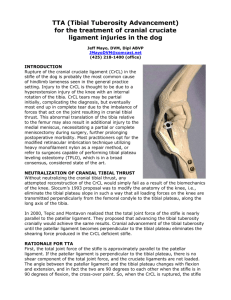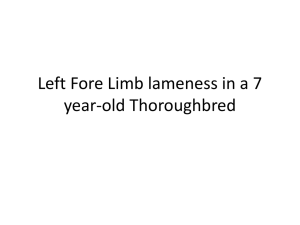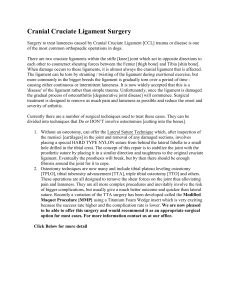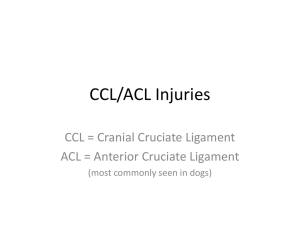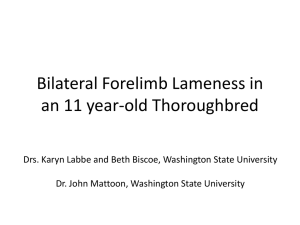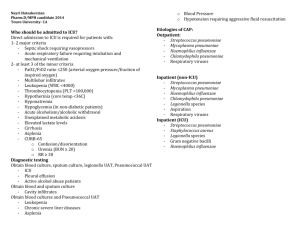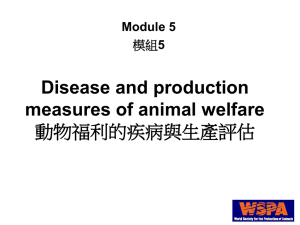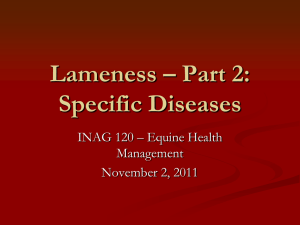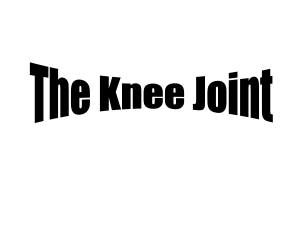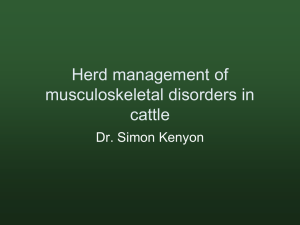Cranial Cruciate Ligament Disease
advertisement
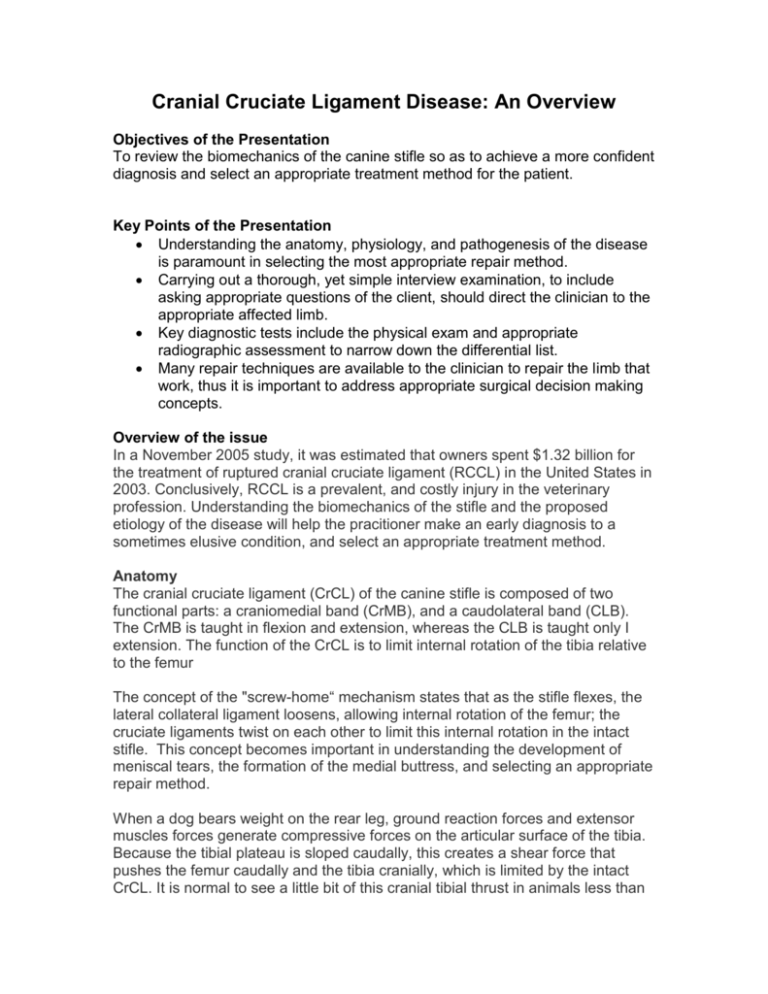
Cranial Cruciate Ligament Disease: An Overview Objectives of the Presentation To review the biomechanics of the canine stifle so as to achieve a more confident diagnosis and select an appropriate treatment method for the patient. Key Points of the Presentation Understanding the anatomy, physiology, and pathogenesis of the disease is paramount in selecting the most appropriate repair method. Carrying out a thorough, yet simple interview examination, to include asking appropriate questions of the client, should direct the clinician to the appropriate affected limb. Key diagnostic tests include the physical exam and appropriate radiographic assessment to narrow down the differential list. Many repair techniques are available to the clinician to repair the limb that work, thus it is important to address appropriate surgical decision making concepts. Overview of the issue In a November 2005 study, it was estimated that owners spent $1.32 billion for the treatment of ruptured cranial cruciate ligament (RCCL) in the United States in 2003. Conclusively, RCCL is a prevalent, and costly injury in the veterinary profession. Understanding the biomechanics of the stifle and the proposed etiology of the disease will help the pracitioner make an early diagnosis to a sometimes elusive condition, and select an appropriate treatment method. Anatomy The cranial cruciate ligament (CrCL) of the canine stifle is composed of two functional parts: a craniomedial band (CrMB), and a caudolateral band (CLB). The CrMB is taught in flexion and extension, whereas the CLB is taught only I extension. The function of the CrCL is to limit internal rotation of the tibia relative to the femur The concept of the "screw-home“ mechanism states that as the stifle flexes, the lateral collateral ligament loosens, allowing internal rotation of the femur; the cruciate ligaments twist on each other to limit this internal rotation in the intact stifle. This concept becomes important in understanding the development of meniscal tears, the formation of the medial buttress, and selecting an appropriate repair method. When a dog bears weight on the rear leg, ground reaction forces and extensor muscles forces generate compressive forces on the articular surface of the tibia. Because the tibial plateau is sloped caudally, this creates a shear force that pushes the femur caudally and the tibia cranially, which is limited by the intact CrCL. It is normal to see a little bit of this cranial tibial thrust in animals less than a year of age, but when detected in a clinically lame animal, it is diagnostic of RCCL. Pathogenesis of Disease Tearing of the CLB (most likely from hyperextension) alone will not produce instability because the intact CMB is taut in both flexion and extension; no drawer motion will be present. Injuries caused by rotation or twisting are more likely to injure the CrMB, producing a small amount of drawer motion in flexion, but none in extension. Rupture occurs when the breaking strength of the ligament is exceeded, thought to be four times the body weight of the dog. The primary pathogenesis of CrCL rupture is the ligamentous changes that occur with disuse, and progressing age. The degenerative changes progress in severity as the animal ages, but seem less severe in animals less than 15 kilograms in body weight. The degenerative changes associated with aging also account for 2040% of dogs with unilateral CrCL rupture that suffer the same consequence of the opposing limb. It is also theorized that the sedentary lifestyle of the typical middle-aged dog, compounded by obesity, may also lead to diminished mechanical strength of the CrCL. Signalment Patients may present for acute RCCL, in which there may be partial-weightbearing or non-weight-bearing lameness. Lameness may resolve in patients weighing less then 15 kilograms in 1-5 months time, although these patients may experience painful meniscal damage later on in life. Patients weighing over 15 kilograms may never return to pre-injury levels of activity without recurrence of lameness, while others may start to use the limb in 2 to 3 weeks and apparently improve for several months before progressing to recurrent lameness and degenerative joint disease. Chronic lameness is associated with development of degenerative joint disease. Patients with a history of chronic lameness often are presented weeks to months after the initial injury. These dogs are thought to stabilize their joint and improve clinically due to hemarthrosis and capsular thickening, only to worsen again as a result of a meniscal tear or progression of degenerative joint disease. Partial CrCL tears are difficult to diagnose in the early stages, and the dog may present with a mild weight-bearing lameness associated with exercise that resolves with rest until degenerative joint disease sets in. As the ligament continues to tear and the stifle joint becomes more unstable, the degenerative changes exacerbate the lameness until it no longer resolves with patient rest. In patients with bilateral RCCL, the history is often described as a shifting leg lameness, trouble rising, and appearing stiff when they first get up or may be reluctant to walk. Physical Exam Upon first entering the examination room, perhaps one of the most valuable (visual) tests for localizing lameness to the affected limb is the sit test. The normal dog sits with the hock in sufficient flexion so the patient rests on its haunches. The abnormal dog may rock from one side to the other, but usually sit with the affected rear leg extended outward. These patients will also rise from sitting by cantilevering over the front end to decrease the quadriceps force and alleviate discomfort in the painful knee. The affected stifle is typically externally rotated (or the tibia internally rotated) in the standing position. During walking, one may notice internal rotation of the tibia, a phenomenon known as pivot shift due to weakness of the biceps femoris muscle group. The presence of a medial buttress, defined as osteophyte formation along the trochlear ridge both, medial and lateral but more palpable and pronounced medially, is considered pathognomonic for CrCL rupture and should be compared with the normal leg to rule out bilateral disease. Significant atrophy of the quadriceps and hamstring muscles is a common finding. Patients with genu varum or valgum have a higher clinical incidence of CrCL rupture. An audible “clicking” may be heard when the patient walks or the stifle is palpated through range of motion, indicating possible medial meniscus tear. Palpation of the joint compartment may show increased joint fluid or joint capsular thickening. The cranial drawer sign or cranial tibial thrust may be positive. Important differential diagnoses to consider in evaluating hind limb lameness are numerous and should include; caudal cruciate tear, medial patellar luxation, osteochondrosis dessicans, neoplastic processes, rupture or avulsion of the long digital extensor tendon, Achilles tendon rupture, lymphocytic plasmocytic synovitis syndrome, contraction of the semimembranosus/gracillus, patellar tendon rupture, other arthropathies, and neurological disease such as cauda equine syndrome. Once the examiner has a high index of suspicion, as evidenced by clinical lameness, positive sit test, positive tibial compression test, cranial drawer test, or the presence of a medial buttress, further diagnostics are indicated. Note that dogs with chronic CrCL damage may not show positive drawer or CTT due to fibrosis inhibiting detectable movement of the stifle joint. Biochemical profile and complete blood count will be unremarkable, with the rare exception of Cushing’s disease33 as a cause of ligament instability, or hypothyroidism and diabetes mellitus as causes of obesity. Synovial fluid analysis may help differentiate partial CrCL rupture, immune-mediated arthropathies, joint sepsis, and acute trauma. Lateral and craniocaudal radiographs are made of the stifle to assist in the diagnosis of CrCL rupture, and rule out other abnormalities. In acute tears, radiographs will help rule out other causes of stifle joint lameness. Radiographic findings in patients (there are over 35 noted in the literature) with chronic tears include: osteophytes along the trochlear ridge and caudal surface of the tibial plateau, and pole of the patella, displacement of the infrapatellar fat pad, and caudal joint capsule distension as evidenced by displacement of the “fat line” or gastrocnemius muscles. If the veterinarian is unsure of the diagnosis at this point, arthroscopy or open arthrotomy are options to confirm the diagnosis of CrCL rupture. Repair Methods Many repair methods are available for RCCL, and they are divided into intraarticular, extracapsular, and extra-articular. Intra-articular methods include: under-over, and over-the-top (Arnoczky 1979). Extracapsular methods include: lateral retinacular imbrication, (Flo 1975), and fibular head advancement (Slocum 1971). Extra-articular methods include: tibial plateau leveling osteotomy (Slocum 1993), and tibial tuberosity advancement (Montavan 2002). Other less popular methods in the US include: triple tibial osteotomy, closing wedge osteotomy, and proximal tibial fusioin.
